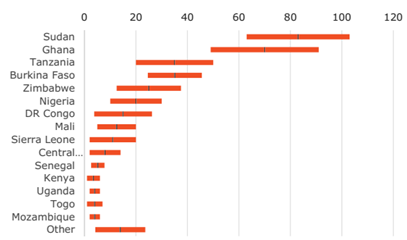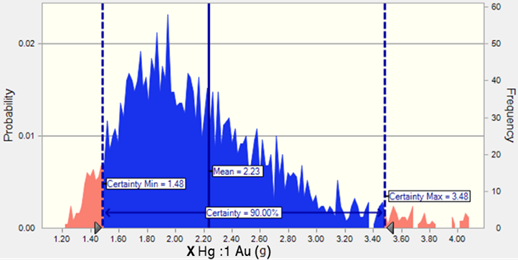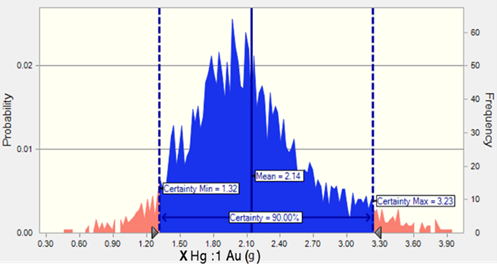Artisanal Gold Mining: Environmental Impacts of Mercury Use
Artisanal and small-scale gold mining (ASGM) is a critical economic activity in Sudan, providing livelihoods for many people across various regions. However, the widespread use of mercury in this sector poses severe environmental and health risks. Recently, these risks have been further exacerbated by the heavy rains and floods that have swept across mining areas, particularly in markets where both the milling and burning of mercury amalgamated gold occur. Figure 1 shows the Geographical distribution of artisanal mining activities (Ibrahim, 2015).

Figure 1: Geographical distribution of artisanal mining activities, after (Ibrahim, 2015).

Figure 2: Estimated mercury consumption for artisanal gold mining
In this article, I explore the environmental impacts of mercury use in ASGM in Sudan, with a focus on soil, water, air, vegetation, wildlife, and human health. I also examine how torrential rains and floods have intensified these impacts, creating new challenges for communities and ecosystems alike.
Soil Contamination
Mercury, a well-known environmental contaminant, is frequently employed in the gold extraction process. This practice can lead to soil pollution through direct spillage during the milling operation or indirect atmospheric deposition from the combustion of amalgam. In certain mining regions where I have worked, the mercury-to-gold ratio utilized in the milling phase has been observed to range from 1.48 to 3.48 grams, with a substantial quantity of mercury being released into the environment.

Figure 3: Process of extracting gold

Figure 4: Mercury to Gold ratio (X Hg:1 Au) loss during milling
The recent heavy rains and subsequent floods are expected to exacerbate soil contamination by dispersing mercury-laden soil across broader areas, including agricultural lands and residential zones. These torrents and floods will likely spread the contamination beyond the immediate vicinity of the mining activities, rendering the land unsuitable for agriculture or other productive uses over a much larger area. The dispersion of mercury through floodwaters significantly increases the risk of widespread soil infertility and disruption of microbial communities, further threatening food security and the sustainability of local ecosystems.
Air Quality Degradation
The burning of concentrated amalgam is a widespread practice within Sudan's artisanal mining sector. In specific mining regions where I have worked, the mercury-to-gold ratio used during the burning phase varied from 1.32 to 3.23 grams of mercury per gram of gold, with an average of approximately 2.14 grams of mercury per gram of gold. This process releases hazardous mercury vapor into the atmosphere, which can be transported over long distances before deposition. Inhalation of these vapors poses significant health risks, including respiratory and neurological impairments, to both miners and surrounding communities. Additionally, atmospheric mercury deposition contributes to soil and water contamination.

Figure 4: Mercury to Gold ratio (X Hg:1 Au) loss during burning burning of concentrated Amalgum
The heavy rains and floods are expected to compound the impact of air pollution by dispersing mercury vapor over a wider area. The turbulent weather conditions associated with the floods will carry mercury vapor and droplets far from the mining markets, where burning occurs, causing mercury to settle in areas previously unaffected. This will lead to new zones of contamination, further degrading air quality and increasing the risk of mercury exposure to a larger population.
Water Pollution
Water bodies near mining areas are particularly vulnerable to mercury contamination. During the gold extraction process, mercury spills into streams and rivers, leading to the contamination of surface and groundwater. The mercury in water can transform into methylmercury, a highly toxic compound that accumulates in aquatic organisms. This bioaccumulation in fish and other wildlife poses risks to ecosystems and the humans who rely on these water sources for drinking, cooking, and fishing.
The torrential rains and resulting floods are expected to dramatically worsen this situation. Floodwaters will wash mercury from mining sites, where both milling and burning are conducted, directly into rivers, streams, and groundwater systems. This will lead to a sharp increase in the levels of mercury pollution in water bodies, expanding the contamination zone and intensifying the risk of methylmercury formation. The floods will thus not only increase the concentration of mercury in aquatic ecosystems but also elevate the danger to communities that depend on these water sources for their daily needs.
Impact on Vegetation
Mercury contamination of soil and water adversely affects plant life. Vegetation absorbs mercury through the roots, leading to stunted growth, reduced agricultural yields, and the death of plants. Contaminated plants can also enter the food chain, posing risks to herbivores and, subsequently, to predators, including humans who consume them.
Floodwaters, driven by torrential rains, will spread mercury-contaminated soil and water over vast tracts of land, severely impacting vegetation. In areas where crops have survived the floods, they are now at risk of absorbing higher levels of mercury, making them unsafe for consumption. This situation threatens not only local agriculture but also the broader ecosystem, as contaminated plants can poison herbivores and, through the food chain, pose risks to humans and predators alike.
Threats to Wildlife
Wildlife, particularly in regions with high levels of mercury pollution, faces significant risks. Aquatic life is especially vulnerable, with fish and other organisms accumulating mercury in their tissues. This bioaccumulation not only affects individual species but also disrupts entire ecosystems. Birds and mammals that feed on contaminated fish or plants may suffer from mercury poisoning, leading to reproductive issues, behavioral changes, and death.
The recent floods will intensify these threats by spreading mercury across wildlife habitats. Aquatic species are now facing even higher levels of mercury exposure, as floodwaters concentrate the contamination in ponds, lakes, and rivers. Additionally, as floodwaters recede, they leave behind pools of mercury-contaminated water, creating concentrated hotspots of pollution that can devastate local wildlife populations. This will lead to a cascade of ecological disruptions, threatening the survival of various species and the balance of ecosystems.
Human Health Hazards
The most concerning impact of mercury use in ASGM is on human health. Miners are directly exposed to mercury during the milling and burning phases, leading to chronic mercury poisoning, characterized by neurological and cognitive impairments, kidney damage, and respiratory problems. The local communities are also at risk through the consumption of contaminated water, fish, and crops. Mercury exposure is particularly dangerous for pregnant women and children, as it can cause developmental delays, birth defects, and other severe health issues.
The flooding will significantly heighten these health risks, particularly in market areas where both milling and burning occur. As mercury spreads through floodwaters into residential areas, more people will be at risk of exposure through contaminated water and food sources. The health implications will be especially dire for vulnerable populations, including children, pregnant women, and the elderly, who are now facing an increased likelihood of mercury poisoning. The long-term health consequences will be devastating, with a potential rise in chronic illnesses and developmental issues within affected communities.

Figure 5: Recent heavy rains and floods in areas of artisanal mining activities
Conclusion
The environmental and health impacts of mercury use in artisanal and small-scale gold mining in Sudan will be profoundly exacerbated by the recent heavy rains and floods. Soil, water, air, vegetation, wildlife, and human health all suffer from the compounded effects of mercury contamination and extreme weather events. The torrents and floods will spread mercury far beyond the immediate mining areas, leading to widespread environmental degradation and escalating health crises.
Addressing these challenges requires a concerted effort to reduce mercury use, promote safer alternatives, and implement effective environmental and health protection measures, especially in the face of increasingly unpredictable and severe weather patterns. The sustainability of Sudan’s gold mining sector depends on balancing economic benefits with the urgent need to mitigate its environmental and health impacts in a changing climate.



